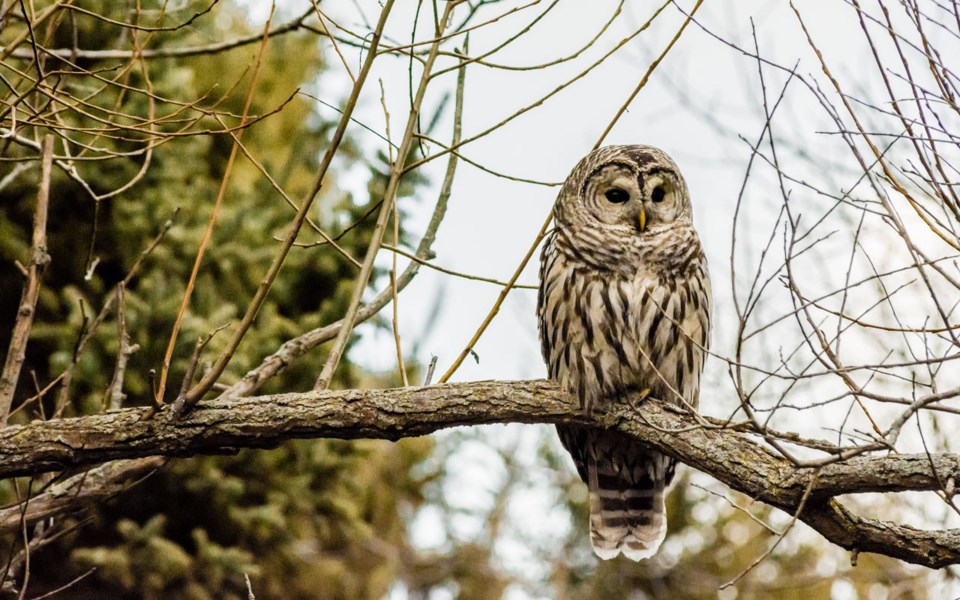The barred owl likes Vancouver. Social media is full of images of the striking bird in unexpectedly urban settings.
A Dec. 7 Vancouver Sun article went so far as to call it a veritable "invasion," noting that 150 of the birds have been brought into a wildlife rehabilitation centre.
Some flew headfirst into vehicles.
One popular photo that has circulated is particularly striking. In it the owl is perched outside of the Burrard Street SkyTrain station. It's white spots look like snowflakes on its meaty, oval-shaped body.
It's got something in its claws. A pigeon? No — a rat. One of the bird's preferred delicacies.
Barred owls are highly adaptable. Provided there is green space and plenty to eat, they can survive in cities.
I had my own encounter with one a few years ago. I was walking out of my grandmother's in Victoria, when I saw it perched on a fence.
I was shocked — and creeped out at how calm it looked. It just sat there, staring at me, unalarmed.
In person, it's a magnificent animal. With its huge Betty Boop eyes, it looks cartoonish — cuddly even.
Lots of people have a soft spot for the animal.
It's call, they say, is distinctive: Who cooks for you?
The bird is new to this part of the world. Native to the East Coast, over the years, it has migrated west, and in the process it has displaced— and even killed — one of the Pacific Northwest's most iconic animals: The spotted owl.
Barred owls are bigger and more aggressive. They also breed more.
According to an article that appeared in Outside magazine, biologist Robin Brown observed that the population of spotted owls near Cle Elum, Wash. dropped 80 per cent between 1992 and 2012, whereas the barred owl thrived. And in the Oregon coastal range, the spotted owl population has been reduced by 70 per cent.
This is a troubling trend as the spotted owl is inextricably linked to efforts to preserve old-growth forests.
In 1990, the bird was declared a threatened species by the U.S. government, making huge swaths of forest off limits to loggers and a desire to save the species has led to a barred owl cull in some parts of B.C. and Oregon.
I can't imagine what it's like to shoot an owl.
From what I gather, they tend to be like the one I saw — super chill.
You can get close to them; they won't necessary move.
Not exactly a challenge for hunters.
Barred owls are also aggressive.
There is already one report of one dive bombing a jogger in Vancouver.
In that Outside article, writer Katherine Malmo writes about their aggressive behaviour.
Some joggers have resorted to wearing hard hats and wielding sticks for protection, she noted.
One attack — which a resulted in a number of serious lacerations to a guy's scull — sounds otherworldly.
"Something landed on Lance's head and began digging its sharp talons into his scalp. Warm blood flowed through his hair. As he flailed his arms in agony, a pair of feathered wings descended over his face, covering his eyes.
"Lance thrashed until the bird withdrew, flying 20 feet (six metres) ahead to a low branch. The two stared at each other in the pale light of the quarter moon."
Right now, Vancouverites seem giddy about barred owls — like wow, they're so cool.
As you read this, someone (an East Coast transplant who just loves Vancouver, surely) is sending a photo to friends and family.
"Look what I just saw!!!!!!!"
In a way, I get that. Living in an urban environment can suck. You rarely see animals — let along cool ones.
In Montreal, the only birds I recall seeing were pigeons. I'd grab a sandwich and go the park. Within moments, a half dozen would appear.
The pigeon — next to the barred owl — is a truly horrendous bird.
One continues to haunt me: Filthy and oily, it looked — and smelled — like it lived in the sewer. Not the kind of thing you want to see while you're trying to eat your lunch.




